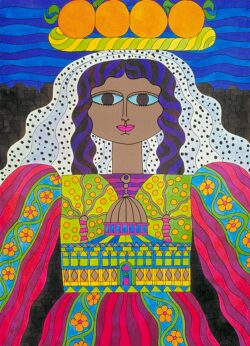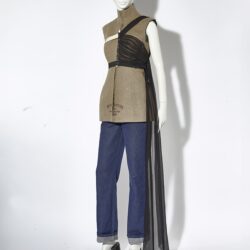
MoMu Expo Visit: Embroidering Palestine
An extraordinary tour through the temporary exhibition for secondary, higher and adult education.
Visitor information
Tickets
When
From 19 December 2025 to 7 june 2026Duration
1 hourLanguages
Dutch & EnglishFor whom
Secondary education, Higher education, Adult educationPractical information
- Tuesday to Sunday from 10 AM - 6 PM
- Maximum 15 students per guide
- €80 per guide (including €5 administration costs)
Booking period
Guided tours can be booked up to 2 weeks before the planned date.
Questions
For questions about your booking, please contact booking@antwerpen.be or +32 3 339 47 00.
Embroidery, called tatreez in Arabic, is the most important cultural practice of Palestine. Historically, Palestinian fashion was defined by diversity, with every region known for distinct textiles, styles and stitchwork. More than a craft, tatreez in the nineteenth and early twentieth centuries was a visual language shared by women, as embroidery reflected its maker’s identity and origins.
This exhibition explores Palestinian embroidery and dress through the lenses of nature, splendour, power and change. Tatreez was a rural craft, embedded in women’s relationship to nature – from motifs inspired by Palestinian flora, to fabrics dyed with indigo grown in the Galilee. At the same time, the splendour of embroidery attested to women’s wealth and status. The wedding was a vital rite of passage, with sumptuous clothing a key element of celebrations. Golden thread, mother-of-pearl shoes, and elaborate headdresses offer a spectacular glimpse of local craftsmanship. Silver jewellery, along with certain tatreez motifs, also held talismanic significance, reflecting the power of clothing to affect and protect the body.
Today, embroidery’s power lies in its connection to Palestinian identity, as a symbol of resistance and solidarity. Since the Nakba, or catastrophe, of 1948, which refers to the mass displacement and dispossession of hundreds of thousands of Palestinians, and the establishment of the state of Israel, tatreez has become a form of cultural resistance, an assertion of identity. The exhibition traces the politicisation of the craft, and the continued inspiration it provides to Palestinian fashion designers in the present.
Campaign image: Jerusalem Is In the Heart, 1977, Helmi El-Touni. Edited by Dar Al-Fata Al-Arabi, Caïro. Source: Palestine Poster Project Archives





